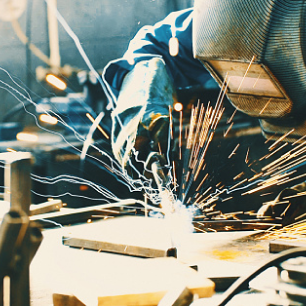Jump to:
Inspection + Testing at Washtenaw Community College
Established in 1966 and located in one of the most educated cities in the country, Washtenaw Community College (WCC) in Ann Arbor is considered to be the number one community college in Michigan. It boasts some of the largest advanced programs that prepare students for high-demand, high-wage jobs in advanced manufacturing, welding, automotive technologies, and other STEM-related professions.
Welding and Fabrication Programs
The college’s welding and fabrication department features highly sought-after programs, including Welding and Fabrication Advanced Applications, Welding Technology, Welding and Fabrication Principles, and more.
Welding and Fabrication Advanced Applications is a high-demand and high-skill advanced certificate program that combines welding fundamentals with more-complex welding, cutting, and fabrication techniques and applications aimed to further develop students’ skills and core competencies. In this program, students weld using processes and positions common in the industry, perform destructive and nondestructive examinations (NDEs), identify weld failures and perform root cause analysis, execute repair techniques, perform advanced fabrication techniques, and execute automated welding and cutting programming and operations.
Welding Technology offers specialized welding and fabrication instruction through theoretical, practical, and technical learning objectives and strategies. The core curriculum specializes in welding and fabrication and delves into the expanses of welding technology as a whole. Students are first introduced to welding, cutting, and fabrication safety and theory and fundamentals. Then they transition to more-
advanced welding and fabrication processes and applications, such as weld quality, inspection testing and repair techniques, and automated welding and cutting systems and operations.
The Welding and Fabrication Principles certificate program introduces students to safe welding and cutting practices and principles, including proper technique and position, weld quality requirements, destructive and NDE methods, print reading and interpretation of welding symbols, and basic metal fabrication. This certificate serves as a fundamental pathway into the Welding and Fabrication Advanced Applications certificate and Welding Technology degree.
Inspection and Testing
NDE has shown to be a vital component of safety protocols and quality assurance in a wide variety of industries. More welding programs are opening classes that are solely dedicated to welding inspection and quality testing, ensuring that NDE is an essential part of the curriculum.
At WCC’s Welding and Fabrication Advanced Applications program, students are required to complete an inspection and testing course that highlights destructive and NDE methods. In this course, students are introduced to the most-common types of weld inspection and testing methods.
“Students start the course by learning about structural code AWS D1.1 [Structural Welding Code — Steel]. Specifically, VT [visual inspection] requirements for both qualification and inspection,” said WCC Instructor Alex Pazkowski, welding and fabrication department. “After that, we introduce destructive methods, such as macro etch, bend testing, and fillet weld breaks. As the semester progresses, we introduce NDE methods.”
The nondestructive methods focus on dye penetrant testing, magnetic particle testing, radiographic testing, and both mono-element angle beam and phased array ultrasonic testing (PAUT). The course also teaches students about different weld discontinuities and defects.
“Students learn how to look at the welds they perform by using all of the inspection methods. We intentionally design the welds so the students will fail. This gives the students an understanding of what causes failures and how to correct them,” said Pazkowski. “We show the students how to perform a failure analysis on their welds by using different modalities of inspection.”
Welding code acceptance criteria are also interpreted and applied to testing methods.
“The students also learn about code and how it relates to what they will see in industry. It’s important to note that we aren’t training inspectors; we’re training welders. Giving welders the ability to analyze their welds makes them better at troubleshooting problems once they enter the industry,” said Pazkowski.
Inspection and Testing Equipment
Pazkowski relies on indispensable NDE equipment to prepare students for real-world, hands-on training. Within the lab, there is a room solely dedicated to the inspection class. For the NDE equipment, students use the General Electric phoenix v|tome|x m 240 computerized tomography machine.
“This allows us to take quick digital pictures of the students’ welds,” said Pazkowski.
For PAUT, students use the Olympus OmniScan MX2 phased array flaw detector.
“They are incredible machines. Despite the fact that UT [ultrasonic testing] is complicated, Olympus has designed an interface that is extremely user-friendly. With minimal guidance, I’m able to teach the students enough to analyze their own welds without hours of lecture on the theoretical aspect of the process,” said Pazkowski.
Professionals Leading Students
The welding faculty delivers comprehensive preparation and experiences for students to tackle just about anything the industry might demand. That is why Pazkowski joined the program in 2010.
“I came to the college with the intent to compete in the SkillsUSA competitions. In 2013, I was able to represent the USA at the WorldSkills Competition, where I placed second. I mention that because my involvement in the competition is what afforded me the outlet to develop the mechanical skills needed to teach people how to weld,” said Pazkowski.
From 2020 to 2023, he served as cochair of the department.
To help students become the well-rounded graduates that employers seek, Pazkowski teams up with fellow full-time instructors Bradley Clink, Ashley Jones, Glenn Kay II, and Amanda Scheffler as well as full-time lab technicians Nathan Oliver, Joe Ortiz, and Jessica King, all of whom are WCC welding and fabrication alumni. All the instructors have a variety of experiences contributing to the program’s depth.
“We all care about the program because we’re all products of its success. We all work to make it better, and the role of the chair is just one of the many jobs we all do to keep the program healthy. It’s a privilege to call this program home. I’m just happy to help,” he said.
Conclusion
The importance of NDE cannot be overstated, as it contributes to safety and quality control. As welding programs and schools grow, courses dedicated to weld inspection and testing are seen as a necessity.
“Inspection isn’t something welders normally learn. Obviously, welding instructors are there to teach people how to weld. What comes with that education is a basic understanding of cause and effect. For example, if I turn the gas off, the result will be cluster porosity,” said Pazkowski. “At a very basic level, the average welding students understand that there are discontinuities and defects that are considered acceptable or unacceptable. Introducing students to welding code and allowing students to test their own welds gives depth to their education. It teaches them the rules of the game and makes them better employees after they leave.”
ROLINE PASCAL (rpascal@aws.org) is associate editor of Inspection Trends.


